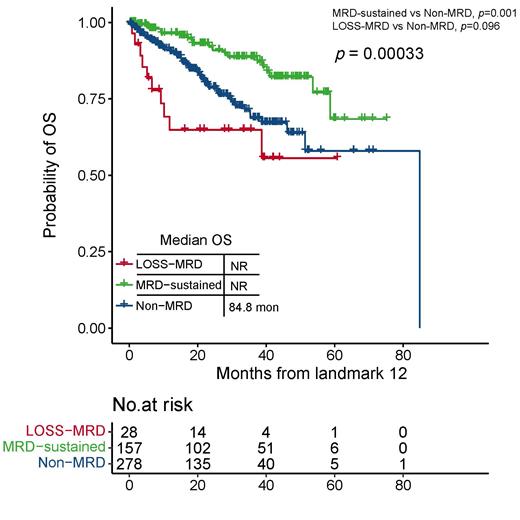Introduction: Achievement of minimal residual disease (MRD) negativity is now recognized as a strong prognostic indicator for favorable clinical outcomes in multiple myeloma (MM) patients. Nonetheless, the optimal duration of MRD-negativity as a surrogate endpoint across different levels of sensitivity remains unclear. Additionally, it is imperative to explore whether sustained MRD-negativity holds the same prognostic value for MM patients with varying risk stratifications.
Methods: In this study, 587 newly diagnosed MM patients were assessed for MRD using multiparameter flow cytometry (sensitivity of 10^-5 or 10^-6) at Zhongshan Hospital Fudan University between January 2014 and Janyary 2022. Patients were categorized as MRD-negativity not obtained (NON-MRD), obtained and sustained (SUS-MRD), or obtained and lost (LOS-MRD) based on their MRD status at given landmark point(4, 6, 12, 18, 24, and 36 months) after initiation of anti-myeloma treatment. The impact of MRD-negativity on survival outcomes was analyzed at increasing landmark times. Univariate and multivariate regression analyses were performed to examine the prognostic implications of time-dependent MRD status on overall survival in the context of different risk-stratification systems which were identified by versions of International Staging System (ISS).
Results: A total of1718 MRD tests were performed on MM patients, the median number was 3. Among survival analyses at differnet landmark time, MM patients at 12 months showed greatest separation in subsequent survival between 3 groups no matter the sensitivity of 10^-5 or 10^-6 ( p=0.032, p=0.03). Pooled analysis indicated that patients who were in SUS-MRD category with a sensitivity ≥10^-5 had superior overall survival (OS) at 12 months landmark point ( p<0.001), with comparable survival between patients in Non-MRD and LOS-MRD category ( p=0.096, Figure 1). SUS-MRD group of MM patients at 12 months did not show better OS than the rest part patients in low-risk subgroup(ISS/R-ISS/R2-ISS=I, p=0.73, p=0.28, p=0.41,respectively). Among high-risk subgroup (ISS/R-ISS=III, R2-ISS=IV), landmark survival analyses at 12 months indicated that SUS-MRD benefited patients most, as shown the greatest OS in the SUS-MRD part ( p=0.013, p=0.011, p=0.056,respectively). Multivariate cox regression analysis showed that SUS-MRD was an independent favorable variable for patients in the ISS/R-ISS=III group ( p=0.021, HR:0.429; p=0.002, HR: 0.161).
Conclusions: No matter the sensitivity of 10^-5 or 10^-6, the sustained of MRD negative lasts for 12 months is a robust marker of superior survival outcomes. MM patients who lost MRD negative has similar OS with those constant MRD positive in the long term. Benefit of Sustained MRD negative in MM limited to high risk subgroup MM patients.
Disclosures
No relevant conflicts of interest to declare.


This feature is available to Subscribers Only
Sign In or Create an Account Close Modal